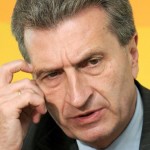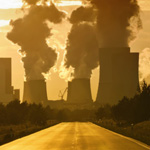
Vilma Radvilaite
The European Commission has just published a mid-term review of its European Energy Programme for Recovery which reveals that offshore wind energy is the strongest performer under the scheme. But what is this scheme all about and how exactly is offshore wind the strongest? The EWEA blog talks to Vilma Radvilaite, Regulatory Affairs Advisor at EWEA to find out…
What is the European Energy Programme for Recovery?
Back in 2009, the EU launched a plan to help Europe face-up to the financial crisis and rising concerns about energy security and climate change. Some €4 billion was allocated to the plan – called the European Economic Recovery Plan (EERP) – focusing on projects that were capable of making quick and effective use of significant amount of funding.
Three areas were considered to meet these criteria: offshore wind energy, gas and electricity infrastructure projects and carbon capture and storage (CCS).
 Tempers seem to have frayed at yesterday’s EU Energy Council over the European Commission’s proposals for an EU-wide energy infrastructure package, the European Voice has reported. Günther Oettinger, European Commissioner for energy, was “visibly frustrated” at the meeting of ministers after many of them said they could not accept transferring authority for energy infrastructure from regions to EU level, the website said.
Tempers seem to have frayed at yesterday’s EU Energy Council over the European Commission’s proposals for an EU-wide energy infrastructure package, the European Voice has reported. Günther Oettinger, European Commissioner for energy, was “visibly frustrated” at the meeting of ministers after many of them said they could not accept transferring authority for energy infrastructure from regions to EU level, the website said.
The news comes as Energy Ministers across Europe were presented with a statement – supported by EWEA, Eurelectric, Europacable and 35 other organisations – calling for an internal EU market for energy and grid extensions and upgrades in order to boost security of supply, achieve our climate goals and bring more renewables online.
 A leading German newspaper, the Frankfurter Allgemeine Zeitung (FAZ), has reported on a leaked European Commission document on energy futures for 2050, saying that the European Commission’s calculations could be questionable.
A leading German newspaper, the Frankfurter Allgemeine Zeitung (FAZ), has reported on a leaked European Commission document on energy futures for 2050, saying that the European Commission’s calculations could be questionable.
In the leaked document – containing seven energy scenarios for 2050 – only the ‘high renewable energy’ scenario shows electricity prices to rise after 2030. In all the other scenarios electricity prices decrease after 2030.
 Representatives of the EU and the US agreed that a global climate change treaty is necessary and achievable at a debate Wednesday. However, while the EU saw achieving US legislation on the matter as crucial, the American line, surprisingly, was to dismiss the relevance of domestic climate change legislation.
Representatives of the EU and the US agreed that a global climate change treaty is necessary and achievable at a debate Wednesday. However, while the EU saw achieving US legislation on the matter as crucial, the American line, surprisingly, was to dismiss the relevance of domestic climate change legislation.
Jos Delbeke, the European Commission’s Director General for Climate Change, expressed the EU’s disappointment at the lack of progress on the US legislation issue, particularly on the falling through of a proposed cap and trade scheme on carbon emissions.
“We would have liked to create a trans-Atlantic carbon market”, he said, adding that it was hard to see how the US would reach the 17% emission reduction target confirmed at the Cancun summit without a cap and trade system.
 By Justin Wilkes
By Justin Wilkes
All 27 National Renewable Energy Action Plans have now been submitted to the European Commission. We at EWEA have done an analysis of the plans. As expected they show that the EU as a whole will exceed its target of 20% of energy from renewables by 2020.
Taking all 27 National Renewable Energy Action Plans together we see that EU countries expect to meet 20.7% of their energy consumption from renewables.
This would mean that 34% of all electricity in the EU in 2020 would come from renewables – 14% from wind energy alone: making wind Europe’s leading renewable energy source.








 Comments
Comments



